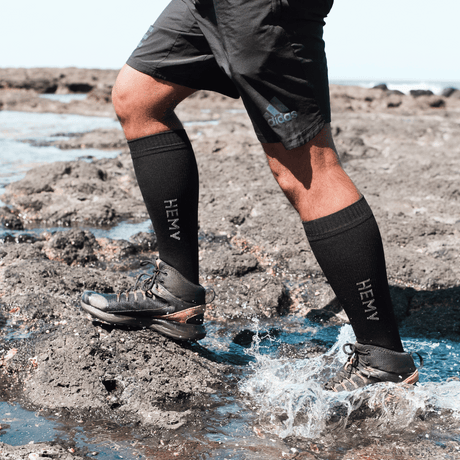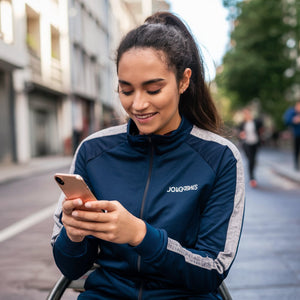Don't Get Soaked: 5 Common Mistakes When Buying Waterproof Socks
Aug 06, 2024
Have you ever been caught in a downpour with soggy feet? Or perhaps you've experienced the discomfort of wet socks during a hiking trip? Waterproof socks can be a game-changer for outdoor enthusiasts and everyday adventurers alike. However, not all waterproof socks are created equal, and making the wrong choice can leave you high and dry – or rather, low and wet. Let's dive into the five most common mistakes people make when purchasing waterproof socks and how you can avoid them.
1. Ignoring the Activity-Specific Requirements
One size doesn't fit all when it comes to waterproof socks. Different activities demand different features.
For Hiking and Trekking
- Look for socks with reinforced heels and toes
- Ensure they offer good breathability to prevent sweating
- Consider the height – ankle-length might not be sufficient for crossing streams
For Cycling
- Opt for socks with extra cushioning in the ball of the foot
- Choose a snug fit to prevent bunching inside cycling shoes
For Everyday Wear
- Prioritize comfort and style alongside waterproofing
- Consider low-cut options for use with regular shoes
"The right waterproof sock for a mountain biker might be all wrong for a city commuter. Know your needs before you buy!" - Sarah Thompson, Outdoor Gear Specialist
Remember, using the wrong type of waterproof sock for your activity can lead to discomfort, blisters, or even defeat the purpose of waterproofing altogether.
2. Overlooking the Importance of Materials
The fabric composition of your waterproof socks plays a crucial role in their performance and durability.
Common Waterproof Sock Materials:
- Cotton
- Merino wool
- Polyester
Each material has its pros and cons. For instance, merino wool offers excellent temperature regulation and odor resistance but may take longer to dry compared to synthetic options.
Waterproofing Technologies:
- HEMY X-WATER Membranes
- DryMax fibers
- Proprietary waterproof coatings
Don't just look at the outer material. The inner lining and the waterproofing technology used are equally important. Some cheaper options might use a simple water-resistant coating that wears off quickly, leaving you with regular socks after a few uses.
3. Disregarding Proper Sizing
Ill-fitting waterproof socks can be worse than no socks at all. Too tight, and they'll restrict blood flow and cause discomfort. Too loose, and you risk blisters and reduced waterproofing effectiveness.
Tips for Proper Sizing:
- Measure your feet at the end of the day when they're slightly swollen
- Consider the thickness of the socks – they're often bulkier than regular socks
- Check the brand's specific sizing chart – sizes can vary between manufacturers
- If between sizes, opt for the larger size for comfort
Remember, your toes should have some wiggle room, but the sock shouldn't bunch up in your shoe.
4. Neglecting Breathability
Waterproof doesn't have to mean sweat-proof. Many people make the mistake of choosing completely impermeable socks, leading to sweaty, uncomfortable feet.
The Importance of Breathability:
- Prevents overheating and excessive sweating
- Reduces the risk of blisters and fungal infections
- Enhances overall comfort during extended wear
Look for socks with breathable membranes or moisture-wicking properties. Some advanced waterproof socks use multi-layer constructions that keep water out while allowing sweat to escape.
"A good waterproof sock should be like a good raincoat – it keeps the rain out but doesn't make you feel like you're wrapped in plastic." - Mike Chen, Avid Hiker and Gear Reviewer
5. Forgetting About Maintenance and Care
Even the best waterproof socks won't last if you don't take care of them properly. Many people treat them like regular socks, which can significantly reduce their lifespan and effectiveness.
Proper Care for Waterproof Socks:
- Follow the manufacturer's washing instructions carefully
- Avoid using fabric softeners or bleach
- Air dry or use a low heat setting in the dryer
- Store them properly – don't just stuff them in a drawer
Some waterproof socks may require occasional reapplication of water-repellent treatments to maintain their effectiveness. Check the care instructions to see if this applies to your socks.
Step Into Comfort and Dryness
Avoiding these five common mistakes can make a world of difference in your waterproof sock experience. Remember to consider your specific needs, pay attention to materials and fit, prioritize breathability, and take good care of your investment. With the right pair of waterproof socks, you can confidently tackle whatever Mother Nature throws your way, keeping your feet dry, comfortable, and ready for adventure.




